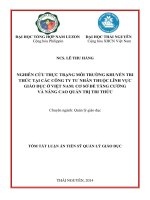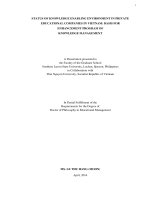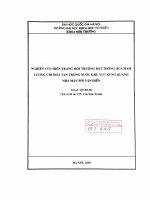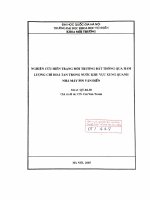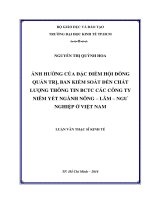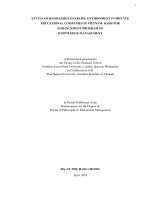Nghiên cứu thực trạng môi trường khuyến tri thức tại các công ty tư nhân thuộc lĩnh vực giáo dục ở việt nam cơ sở để tăng cường và nâng cao quản trị tri thức ( Luận án tiến sĩ)
Bạn đang xem bản rút gọn của tài liệu. Xem và tải ngay bản đầy đủ của tài liệu tại đây (2.94 MB, 157 trang )
i
STATUS OF KNOWLEDGE ENABLING ENVIRONMENT IN PRIVATE
EDUCATIONAL COMPANIES IN VIETNAM: BASIS FOR
ENHANCEMENT PROGRAM OF
KNOWLEDGE MANAGEMENT
A Dissertation presented to
the Faculty of the Graduate School
Southern Luzon State University, Lucban, Quezon, Philippines
in Collaboration with
Thai Nguyen University, Socialist Republic of Vietnam
In Partial Fulfillment of the
Requirements for the Degree of
Doctor of Philosophy in Educational Management
MS. LE THU HANG (MOON)
April, 2014
ii
APPROVAL SHEET
In partial fulfillment of the requirements for the degree Doctor in Education
Management, this research study entitled “Status of knowledge enabling environment in
private educational companies in Vietnam: basis for enhancement program of
knowledge management” has been submitted by Ms. LE THU HANG (MOON), and is
hereby recommended for oral examination.
PROF. DR. CECILIA N. GASCON
Research Adviser
Approved by the Oral Examination Committee, in partial fulfillment of the
requirements for the degree Doctor in Education Management offered by Southern Luzon
State University, Republic of the Philippines in collaboration with Thai Nguyen
University, Socialist Republic of Vietnam.
DR. WALBERTO A. MACARAAN
DR. TERESITA V. DELA CRUZ
Member
Member
DR. APOLONIA A. ESPINOSA
DR. BELLA R. MUELLO
Member
Member
DR. NORDELINA ILANO
Member
DR. CECILIAN N. GASCON
Chairman
iii
Accepted in partial fulfillment of the requirements for the degree Doctor in
Education Management offered by Southern Luzon State University, Republic of the
Philippines in collaboration with Thai Nguyen University, Socialist Republic of Vietnam.
DR. TERESITA V. DELA CRUZ
DR. WALBERTO A. MACARAAN
Dean, Graduate School
Vice President for Academic Affairs
Date___________________
.
iv
ACKNOWLEDGEMENT
First of all, I am most grateful to my adviser, Prof. Dr. Cecilia N. Gascon, for her
valuable academic and moral support, which I shall never forget, during the doctoral
program in education management of Southern Luzon State University of the Philippines. I
highly appreciate very helpful suggestions made by Prof. Dr. Dang Quoc Bao about the
research at an early stage in its development.
I wish to record my particular thanks to Dr. Teresita V. Dela Cruz, Dr. Apolonia
A. Espinosa and Dr. Walberto A. Macaraan, Dr. Bella R. Muello, Southern Luzon State
University, for their constructive and useful advice to improve the dissertation.
While collecting data for this research, I was lucky enough to receive support
from a number of colleagues and friends of EduTrust and Vietnam Chamber of Commerce
and Industry in Hanoi and Ho Chi Minh City. At the EduTrust, thanks are due to
colleagues of the office of the Chairman. Vietnam Chamber of Commerce and Industry,
special thanks go to Le Thuy, Project Director.
In addition, I am indebted to leaders and staff of Thai Nguyen University, of ITC
for their enthusiastic supports during the program as well as to Dr. Judith Narrow and Dr.
Bertil Olsson, Dalarna University, Sweden, for their moral support at the most difficult
moments.
Also, I would like to express my gratitude to all interviewees and group
discussants who took the time to share their lives and thinking with me and thus enriched
my understanding of the problems to which this dissertation addresses itself.
Last but not least, I dedicate this work to my family members, with thanks for all
they have done for me over the years.
Le Thu Hang (Moon)
v
TABLE OF CONTENTS
TITLE PAGE .......................................................................................................... i
APPROVAL SHEET .............................................................................................. ii-iii
ACKNOWLEDGMENT ........................................................................................ iv
TABLE OF CONTENTS ....................................................................................... v-vi
LIST OF TABLES .................................................................................................. vii
LIST OF FIGURES ................................................................................................ viii
LIST OF APPENDICES ........................................................................................ ix
ABTRACT ............................................................................................................... xiii
Chapter 1. INTRODUCTIOIN
Background of the Study ............................................................................... 1
Statement of the Problem .............................................................................. 3
Hypothesis ..................................................................................................... 4
Significance of the Study .............................................................................. 4
Research scope, paradigm and limitations ..................................................... 4
Definition of Terms ....................................................................................... 5
Chapter 2. REVIEW OF LITERATURE AND CONCEPTUAL FRAMEWORK
Review of Literature ..................................................................................... 12
Conceptual Framework ................................................................................. 22
vi
Chapter 3. RESEARCH METHODOLOGY
Locale of the Study ....................................................................................... 39
Research Design ............................................................................................ 39
Population and Sampling .............................................................................. 41
Research Instrumentation and Data Gathering ............................................. 42
Statistical Treatment ..................................................................................... 47
Chapter 4. ANALYSIS, PRESENTATION AND INTERPRETATION OF DATA
Chapter 5. SUMMARY, CONCLUSIONS AND RECOMMENDATIONS
Summary of findings ...................................................................................... 75
Conclusions ................................................................................................... 80
Recommendations ......................................................................................... 81
BIBLIOGRAPHY ................................................................................................... 82
APPENDICES ......................................................................................................... 89
RESEARCHER’S PROFILE ................................................................................ 143
vii
LIST OF TABLE
Table No.
Page
Table 1
Summary of the aspects within human resources and its
management
23
Table 2
Summary of the aspects within the communication activities of
the company
29
Table 3
Summary of the aspects within the information technology
infrastructure
31
Table 4
Summary of the aspects of the learning arenas
Table 5
Summary of the aspects of the use of knowledge
37
Table 6
Number of employees per company and contract arrangements
51
Table 7
Knowledge enabling constructs scales binary recoded through the
median split method by company
63
Table 8
Bivariate Pearson correlation between construct scales and
effective measurements
66
Table 9
Bivariate Pearson correlations of the knowledge creating
indicators
69
Table 10
Knowledge creation indicators binary recoded through the median
70
33-34
split method by company and sector
Table 11
Bivariate Pearson correlation between knowledge enabling
71
constructs and knowledge creation indicators
Table 12
Pearson correlation among knowledge creation and effectiveness
indicators
73
viii
LIST OF FIGURES
Figure No.
Page
Figure 1
Research paradigm
5
Figure 2
Knowledge management and lifelong learning
13
Figure 3
Knowledge management activities
20
Figure 4
Conceptual framework for knowledge management in SMEs
22
ix
LIST OF APPENDICES
Appendix
Page
Appendix A
Communication letters
90
Appendix B
Interview, questionnaire and document data
92
Appendix C
Descriptive Statistics
108
Table 1
Number of employees per company and contract arrangements
Table 2
Number of employees per company and type of professional role
(professional, supports or leaders)
Table 3
Number of employees per company and contract arrangements
Table 4
Number of respondents by educational attainment as a
percentage of all respondents
Table 5
Number of tiers and work organization
Table 6
Recruitment and selection aspects
Table 6a
Frequency of the methods for advertising available positions
Table 6b
Frequency of the method of selecting employees
Table 6c
Frequency of the different selection criteria
Table 7
Aspects related with new recruitments
Table 7a
Policy for new employees
Table 7b
Having a mentor
Table 7c
Policy for newly employed
Table 8
Aspects within employee turnover
Table 9
Criteria to determine salaries
Table 10
Companies salary level
x
Table 11
Bonus system
Table 12
Aspects within the communication activities
Table 12a
Number of companies by frequency of the general information
meetings by sector
Table 12b
Number of companies by scheduled meetings of professional
workers and sectors
Table 12c
Companies with newsletter by sector
Table 12d
Number of companies by person in the gatekeeper position and
sector
Table 13
Number of hour formal and informal meetings (cells refers to
percentage of respondents)
Table 14
Respondent’s perceived usefulness of formal and informal
meetings
Table 15
Distribution of information (cells refer to percentage of
respondents)
Table 16
Information technology infrastructure
Additional tables
Table 1
Workforce stability indicators
Table 2
Bivariate Pearson correlations of the binary recoded indicators of
the stability construct in the selected companies (above 0.4)
Table 3
Workforce experience indicators
Table 4
Professionalism indicators
Table 5
Bivariate Pearson correlation of the binary recoded indicators of
the professionalism construct in the selected companies (above
0.3)
Table 6
Recruitment policy indicators
Table 7
Company monetary reward system indicators
Table 8
Bivariate Pearson correlation of the binary recoded indicators of
the monetary reward aspect construct in the selected companies
(above 0.4)
xi
Table 9
Communication patterns indicators by company
Table 10
Information technology infrastructure indicators by company
Table 11
Bivariate Pearson correlation of the binary recoded indicators of
the information technology investment binary indicators (above
0.40)
Table 12
ANOVA of course length by sector (consultancy and education)
Table 13
ANOVA of course training cost by sector (consultancy and
education)
Table 14
Number of training events and yearly estimated training time by
purpose of training and company
Table 14a
(Cont’d): Number of training events and yearly estimated training
time by purpose of training and company
Table 15
Average scores and standard deviations of the informal learning
items by company
Table 15a
(Cont’d): Average scores and standard deviations of the informal
learning items by company
Table 16
Total variance explained by the factor analysis of the knowledge
creation indicators
Table 17
Rotated component matrix from the factor analysis of the
knowledge creation
Table 18
Bivariate Pearson correlation between knowledge enabling
construct and knowledge-creation indicators in each service
Table 18a
(Cont’d) Bivariate Pearson correlation between knowledge
enabling construct and knowledge creation indicators in each
service
xii
Title:
STATUS OF KNOWLEDGE ENABLING ENVIRONMENT
IN PRIVATE EDUCATIONAL COMPANIES IN
VIETNAM: BASIS FOR ENHANCEMENT PROGRAM OF
KNOWLEDGE MANAGEMENT
Researcher:
Ms. LE THU HANG, MA.
Degree
Doctor of Philosophy, Education Management
Name/ Address of the
Southern Luzon State University
Institution
Graduate School
Lucban, Quezon
Date Completed
April 2014
Adviser
Dr. Cecilia N. Gascon
xiii
ABSTRACT
The dissertation is an exploration of the ways Vietnamese knowledge intensive
companies manage their knowledge. By doing analysis in private educational Vietnamese
companies providing educational and consultancy services, the study explores the
relationship between the “knowledge enabling environment” and the demand for training.
These companies have participated in the program for developing employee competence,
financed by Asian Development Bank (ADB). As results of the program these companies
have evaluated their business activities and determined their training needs in order to
remain competitive.
In this study knowledge is understood not only the structure but also the content
of mental schemas, which embodies in individuals and can be tacit or explicit. It really
differs from information and data and it is through the dialectic process that people learn.
Looking at organizational processes for managing knowledge, it is important to consider
formal organized activities for learning as well as informal learning activities which
constitute so called “knowledge enabling environment”. It is argued here that through the
knowledge management, companies are indeed implementing strategies for the promotion
of lifelong learning, which has recently been used in policy arenas as a guiding principle
for educational policies and reforms.
As results of the study, the different aspects of the equally heterogenous
“knowledge enabling environment” do not present strong relationships in both education
and consultancy companies. Each company in those fields is rather unique in organization
and promotion of knowledge intensiveness in their ordinary business activities. The
companies mainly provide training with the company profile. It is interesting to find out
that employees demand for training if their engagement in informal learning is low.
1
CHAPTER 1
INTRODUCTION
1.1. Background of the Study
According to the World Bank the competitiveness index of human resources in
Vietnam reached 3.39/10 point and competitiveness of Vietnam economy reached 73/133
among participated countries. Furthermore the recent social survey showed that the capital
scale of enterprises is rather small. Nearly 50% of businesses have their capital less than 1
billion VND. While nearly 75% of enterprises with capital of less than 2 billion VND, 90%
of enterprises have their capital of less than 5 billion VND. Due to the small capital scale,
enterprises of Vietnam seem to be less competitive. The innovation and technology of
enterprises are critical.
Concerning human resources in small and medium enterprises (SMEs), the number
of PhDs accounted for only 0.66% while masters composed of 2.33%; labor graduated
from universities and colleges as 41.38% while graduators of vocational schools as
12.33%. It is noteworthy that a part of business owners who got their education from
colleges and universities are not equipped with knowledge of economy, business
administration and human resource management. This has a great influence on the
development of strategic planning, direction and management of business enterprises.
Regarding technology, only about 8% of enterprises reached advanced level of technology.
Most of them are FDI enterprises. Domestic enterprises are using less competitive
technology. In addition, the indicator on ICT use also showed that though businesses (more
than 60%) use computers but only 11.55% use internal network – LAN and 2.16% with
own websites. It is really critical for ability of enterprises to participate in electronic
commerce and communication network as expected and desired by the government. It
showed that technical issues, technology and innovation have not been highly considered
by enterprises, which is one of determining factors of business success in the market.
To serve the cause of industrialization and modernization of the country and to
foster significant participation in globalization, important legal documents have been
issued, especially the economic and social development strategy of 2011-2020 including
the Resolution on Vietnam Workforce Development to the year 2020 adopted at the 11th
Party Congress (April of 2011). Followed the Resolution are the Decision No. 579/QDTTg of strategy on human resource development approved by the Prime Minister on April
2
19th, 2011 and the Decision 1216/QD-TTg of planning on Vietnam human resource
development for 2011-2020 approved by the Prime Minister on July 22nd, 2011. According
to those documents, in the next 10 years it should increase the rate of trained human
resource in the economy with reasonable structure. The total number of trained manpower
in 2015 has been expected to be about 30.5 million people and in 2020, there are nearly 44
million people (representing approximately 70.0% of the nearly 63 million people
employed in the economy). From the total number of trained manpower, the number of
trained personnel through vocational training system in 2015 is expected about 23.5
million (by 77%) and in 2020 - about 34.4 million people (by 78.5%); the number through
the education and training system in 2015 accounts for approximately 7 million people (by
23%) and in 2020 approximately 9.4 million people (by 21.5%).
In the context of knowledge economy, a lot of workshops and conferences of
knowledge management have been held recently in many sectors of Vietnamese
economy, both public and private ones. The major comments have been largely agreed that
many businesses in Vietnam are now just focusing on the issues such as production, cost
reduction while leaving behind the issue of knowledge management, which can support
leadership to solve business problems. E.g. when a company faces a brain drain, business
is interrupted or affected at least until a matching replacement is found. However, the
situation could have been avoided if companies perform well the task of knowledge
management, which is implemented by collection, storage, sharing and use of information
and trade secrets, not only at individual levels but at the level of the enterprise. Then a
mechanism and a process of creation, storage, sharing and development of knowledge in
each business are required so that the knowledge of individual turns into knowledge assets
of the enterprise. Take a look at another example where a business leader needs to make a
quick business decision. In the case the department of business development can assist the
board of directors in strategic insights on commercial viability, in consideration of risks
and competitors, in analysis of strengths and weaknesses as well as necessary financial
resources. The above mentioned department plays here the role of a unit of knowledge
management with comprehensive information and accurate business lines as well as the
knowledge enabling environment. It is noteworthy that to promote knowledge efficiency, a
few training sessions to transfer knowledge to staff is not enough. Some factors that
contribute to the success of knowledge management have been listed in the workshops and
conferences mentioned above: (1) the relationship between knowledge and business
effectiveness; (2) proper system and infrastructure (data storage, information exchange,
3
knowledge transfer to users…); (3) experts on knowledge management to support both
leaders and employees.
From the early 1980s knowledge management was typically associated with the use
of information technology, knowledge based systems, portals and data repositories in
companies. Starting around the year 2000, knowledge management has grown to become
an integral part of basic management, especially in knowledge intensive organizations and
in non-IT related organizational processes. In this incarnation, knowledge management
integrates all organizational processes that are directed towards knowledge creation and
use, and information distribution and storage. Despite the central role that knowledge
creation plays in knowledge management, few references to educational science and
learning can be found. Therefore exploring how knowledge management is related to
training activities in organizations is an interesting and useful endeavor. As studies within
the area of human capital theory have found that small companies face more problems in
providing training opportunities to their employees than large firms. In addition, it has
been found that certain company and work characteristics, such as size of the company,
and literacy practices at work, are associated with higher levels of training participations.
Thus, it seems particularly interesting to explore the relationship between the way small
and medium organizations manage their knowledge and their demand for training.
1.2. Statement of the problem
It is sought answers to the following questions:
1. What is the knowledge enabling environment in selected companies in
education and consultancy?
2. What are the instructional variables that influence the knowledge enabling
environment and knowledge management in selected companies in education and
consultancy?
3. Is there any significant relationship between the company perceived needs for
continuous competence development, which constitute the company demand for training in
selected companies in education and consultancy?
4. What enhancement program of knowledge management can be proposed from
the results of the study?
4
1.3. Null Hypothesis
There is no significant relationship between knowledge enabling environment
and knowledge management.
1.4. Significance of the study
This study would be beneficial to the following:
Administrators and leaders. It is hoped that the study may contribute in giving a
new dimension in knowledge management. The study would provide administrators and
leaders with a clear idea and model of knowledge management. In the same manner, their
practice of knowledge management could give a fresh perfective in terms of its influence
to the overall SMEs in education and consultancy.
Future Researchers. This study could provide references for future proponents
who wish to venture a study similar to the nature of this ongoing research. Thus, basic
tenets on knowledge management and novel dimensions on instructional variables could
serve as resources for other studies.
1.5. Research scope, paradigm and limitations
The study is limited to private educational companies that provide a rich amount
of information and constitute interesting cases for the purpose of the dissertation. They are
small and medium private Vietnamese companies that work within two services that can be
considered “knowledge intensive” consultancy and education. The companies are a selfselected sample of a very particular kind. All the companies have applied and received
grants from the ADB for competence development. This provided an opportunity to gain
access to specific information on the demand for training that would be very difficult to
obtain in any other sample. However, from initial group of 119 companies agreed to
participate in this study, only 18 companies provided a satisfactory amount of information
for the case study in the end. Thus, it is important to note that the results of this study can
only be generalized with caution to other small knowledge intensive enterprises. The two
services under study present different gender balances, which might affect the way
companies approach knowledge management, although this has not been taken up in the
study.
5
1.
2.
3.
4.
5.
6.
7.
8.
9.
Independent Variables
Dependent Variable
Knowledge enabling
environment
Knowledge Management:
Use of knowledge
+ Knowledge creation
Size
Stability of workforce
Experience
Professionalism
Recruitment
Reward system
Communication
IT
Learning arenas (training
and learning activities)
Collaborative climate
index
Profit
Innovation
Offering enhancement program of knowledge management
in private educational companies in Vietnam
Figure 1: Research paradigm
1.6. Definition of terms
Collaborative climate index
The organization’s ability to transfer knowledge from one unit to another in a
collaborative manner has been found to contribute to the organizational performance of
firms in both the manufacturing and service sectors. The benefits of knowledge sharing
have been documented in many settings, but the effectiveness varies considerably among
organizations. It is presented in the so called Collaborative Climate Index (CCI).
Communication
Communication is the activity of conveying information through the exchange of
thoughts, messages, or information, as by speech, visuals, signals, written, or behavior. It is
the meaningful exchange of information between two or more living creatures.
Communication may be intentional or unintentional, may involve conventional or
unconventional signals, may take linguistic or non-linguistic forms, and may occur through
spoken or other modes. Communication requires a sender, a message, and a recipient,
6
although the receiver does not have to be present or aware of the sender's intent to
communicate at the time of communication; thus communication can occur across vast
distances in time and space. Communication requires that the communicating parties share
an area of communicative commonality. The communication process is complete once the
receiver understands the sender's message.
Company Size
Company size refers to the personnel number or employees margin of company.
Besides company size can be considered on industry, ownership structure and revenue.
Dependent Variable
Variables used in an experiment or modelling can be divided into three types and
dependent variable is one of them. Dependent variables represent the output or effect, or is
tested to see if it is the effect. In a scientific experiment, you cannot have a dependent
variable without an independent variable.
Independent Variable
Variables used in an experiment or modelling can be divided into three types:
dependent variable, independent variable, or other. Independent variables represent the
inputs or causes, or are tested to see if they are the cause.
Information Technology (IT)
Information technology (IT) is the application of computers and telecommunications
equipment to store, retrieve, transmit and manipulate data, often in the context of a
business or other enterprise. The term is commonly used as a synonym for computers and
computer networks, but it also encompasses other information distribution technologies
such as television and telephones. Several industries are associated with information
technology, including computer hardware, software, electronics, semi-conductors, internet,
telecom-equipment, e-commerce and computer services.
Innovation
Innovation is the application of better solutions that meet new requirements, inarticulated needs, or existing market needs. This is accomplished through more
effective products, processes, services, technologies or ideas that are readily available
to markets, governments and society. The term innovation can be defined as something
original and, as a consequence, new, that "breaks into" the market or society.
7
Knowledge
Knowledge is in people’s heads, it differs from information or data, it is individual,
and in some instances it can be made public or shared as information. In addition, the
difference between various types of knowledge has been explained in terms of content.
Andriessen (2004, p. 97) identifies six different metaphors in his analysis of the treatment
of knowledge in key publications of the knowledge management field: knowledge as
something physical, as a wave, as a living organism, as thought and feelings, as a process
and as a structure.
In the present work, knowledge is understood both as the structure and the content
of the mental schemas. Therefore, this study uses knowledge as “something physical” and
“as a structure” as defined by Andriessen. It also includes the idea of knowledge as
feelings since the schemas have important emotional components. Further, it includes
knowledge as a process, as a wave and as a living organism, since these three elements
refer to the idea that knowledge is in a constant dialectic process with the reality it
represents. The frame and the content are reinforced or change in each action that we
perform. It is through action that we test our schema in the real world. This action will
inform us about the schema that in tum will or will not change. In this way, action
develops our knowledge, and knowledge is therefore a dynamic entity. Knowledge as a
static entity never changes. The positivistic view of science maintains that scientific
inquiry looks for objective and universal knowledge, what traditionally has been called
Truth with a capital T. However, post-positivistic views criticize the idea of a universal
truth and propose the existence of different truths. Thus there is not a unique, invariant
knowledge but different types of knowledge viewed from different perspectives.
The dynamic feature of knowledge is thus related to the idea that knowledge must
be translated into and associated with action (Elkjaer, 2003; Hunt, 2003). Further, the
action uses knowledge but does not “consume” the knowledge that can be re-used in its
modified form. Thus it is important to mention that “knowledge is not ‘consumed’ in a
process, it sometimes increases through use” (Hall, 1998, p. 13). Through this process of
adaptation, or equilibrium in Piaget’s terms, knowledge, action and learning are closely
linked together.
8
To conclude, it is important to note that knowledge is related to learning. Li et al.
(2003, p. 17) argue: “learning and knowledge mutually reinforce each other in a cycle. The
act of learning provides knowledge and understanding, which in turn feed further
learning”. As has been argued already, learning can be regarded as the adaptation of
mental structures to the specific realities that an individual confronts. Knowledge,
understood both as content and as schema, will therefore be constructed during this process
of adaptation through its interaction with the environment. When we are presented with
data (facts, impressions), we will examine that specific information which has some
meaning and structure for us with the knowledge that we already have. In fact, the previous
knowledge will guide the type of data that we seek, or beyond that, the information we
seek and are capable of understanding. If that specific information content (either knowwhat, why, how or who) appears in adequate conditions of motivation, interest and
attention, the content will be “absorbed” into the mental model (or theory) that we are
applying to that specific context. The new content might not produce much change in the
structure of the mental model, it might produce partial modification (beta answer) or it
might result in a critical modification (gamma answer, significant learning or conceptual
change). These changes in our schema constitute, in fact, learning. Learning is the process
of transforming data into knowledge, making something public (information) into
something private knowledge). The process of transforming knowledge into data is the
process of teaching, understood broadly. The information that starts the process of learning
is usually the articulation of someone’s knowledge that served to codify and externalize
her/his knowledge. If the students (or any listener or reader) incorporate the data that has
been externalized, then there is learning.
Finally, it is important to mention that knowledge can be acquired through different
means. Knowledge is not only created through theoretical means (such as reading or
analyzing information); learning also occurs by doing. Thus when we act, our acts “teach”
us, providing us with information on our performance. This process of learning is not
necessarily a conscious one, and can occur implicitly without the individual realizing it; in
this way we acquire tacit knowledge.
9
Knowledge creation
Organizational knowledge creation is a part of the knowledge management
process. Knowledge creation is about continuous transfer, combination and conversion of
the different types of knowledge (as users practice, interact and learn). Knowledge creation
is a product of the interplay between knowledge and knowing them. The shift in condition
between the possession of knowledge and the act of knowing - something that comes about
through practice, action, and interaction- is the driving force in the creation of new
knowledge. Furthermore, in order for this interplay to be most fruitful, it is important to
support unstructured work environments in areas where creativity and innovation are
important.
Knowledge enabling environment
Knowledge enabling environment refers to the organization of company, the ways of
working and the facilities that employees have in order to deliver services and constantly
upgrade their knowledge. Such an environment constitutes a knowledge intensive
organization (where knowledge is produced and sold). The knowledge enabling
environment encompasses main areas: human resources and its management,
communication activities and information technology infrastructure.
Knowledge management
Knowledge management is the process of capturing, developing, sharing, and
effectively using organizational knowledge. It refers to a multi-disciplined approach to
achieving organizational objectives by making the best use of knowledge. Knowledge
management efforts typically focus on organizational objectives such as improved
performance, competitive advantage, innovation, the sharing of lessons learned, integration
and continuous improvement of the organization.
Learning arenas
Leaning arenas relate to professional development programs, training and learning
activities. It focuses on abstract concepts, complex theoretical understandings and
interactions across many contexts, such as learning experiences and integrating
observation, planning and assessment seem to require long timeframes for new
understandings and ways of working to become embedded in pedagogy. Intensive
opportunities to practice may help sharpen the intensity and effects of the program. While
opportunities to practice are important, this does not imply a lack of value in one off
10
seminars and conferences, which may play a role in “awakening interest” or ongoing
reflection being challenged through exposure to new theoretical ideas and views. It is
unlikely however, that such opportunities on their own would directly change practice in
such a way as to impact on outcomes for diverse learners.
Professionalism
Professionalism is defined as one's conduct at work. In spite of the word's root, this
quality is not restricted to those in occupations described as "professions", typically those
which require a high level of education and have high earnings.
Profit
A financial benefit that is realized when the amount of revenue gained from a
business activity exceeds the expenses, costs and taxes needed to sustain the activity. Any
profit that is gained goes to the business owners, who may or may not decide to spend it on
the business.
Recruitment
Recruitment refers to the overall process of attracting, selecting and appointing
suitable candidates to one or more jobs within an organization, either permanent or
temporary. The term may sometimes be defined as incorporating activities which take
place ahead of attracting people, such as defining the job requirements and person
specification, as well as after the individual has joined the organization, such
as induction and on boarding. Recruitment can also refer to processes involved in choosing
individuals for unpaid positions, such as voluntary roles or training programs.
Reward system
Employee reward systems refer to programs set up by a company to reward
performance and motivate employees on individual and/or group levels. They are normally
considered separate from salary but may be monetary in nature or otherwise have a cost to
the company. While previously considered the domain of large companies, small
businesses have also begun employing them as a tool to lure top employees in a
competitive job market as well as to increase employee performance. Although employee
recognition programs are often combined with reward programs they retain a different
purpose altogether. They are intended to provide a psychological - rewards a financial benefit. Although many elements of designing and maintaining reward and recognition
systems are the same, it is useful to keep this difference in mind, especially for small
business owners interested in motivating staffs while keeping costs low.
11
Stability of workforce
Workplace stability is a major factor in levels of employee morale. People who work
together for long periods of time get to know each other, and a workplace with no paranoia
about layoffs and job loss is a much more pleasant place in which to work. Benefits are an
important factor for many people in their choice of jobs. Good benefits will entice many
people to remain at jobs they might otherwise leave.
Work experience
Work experience is any experience that a person gains while working in a specific
field or occupation, but the expression is widely used to mean a type of volunteer work that
is commonly intended for young people - often students - to get a feel for professional
working environments.
12
CHAPTER 2
REVIEW OF LITERATURE AND CONCEPTUAL FRAMEWORK
This chapter presents the relevant readings, related literature and conceptual
framework which bear significance and similarities in this study.
2.1. Review of Literature
Before presenting the model for knowledge management defended in this
dissertation, it is important to acknowledge where knowledge management comes from
and the contribution of other fields in the study of training and skill development in
organizations. The next sections will discuss different management approaches to the
promotion of learning at work, such as human capital theory, organizational learning and
intellectual capital. It will also show the connection between these different fields and
knowledge management as well as why knowledge management was chosen as the main
field within this dissertation.
Learning is the process of creating knowledge and knowledge guides the process of
learning. Our knowledge is constantly changing; in other words we are continually
learning throughout our entire life span and in all different kinds of settings. The concept
of lifelong learning seems useful in this context. It has been used mainly by
intergovernmental organizations as a guiding principle for educational policies.
The assumption of this dissertation is that knowledge management is indeed an
employer strategy for lifelong learning through structuring “everyday activities” in a way
that promotes constant knowledge creation. Knowledge management, as will be defined
later, refers to the different business activities directed toward the creation, storage,
distribution and use of knowledge and information. Knowledge management creates an
environment for constant skills formation and learning, what von Krogh et al. (2000) call
“the knowledge enabling environment”. On the one hand, knowledge management
strategies enforce a lifelong perspective of learning through the continuous emphasis on
the creation of knowledge and skills upgrading. On the other hand, knowledge
management strategies promote constant opportunities for skill development and learning,
both formal and informal. Knowledge management includes formal learning activities,
